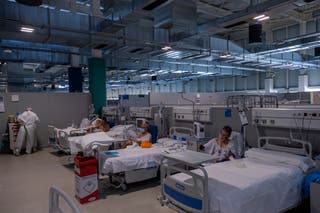Isolating the Source of the Outbreak

The coronavirus or SARS-CoV is a respiratory pathogen that causes serious acute respiratory infections
It is caused primarily by the SARS virus, but other related viruses such as the Hendra virus and the Junin virus can also cause this disease. The SARS virus causes severe respiratory symptoms in human beings but is not able to survive outside its host body, so the illness is termed as "non-specific." Older people with lung or heart disease appear to be at greater risk for contracting more serious complications from SARS-CoV infection.
Unlike other common viruses, the human beings are the only organisms that have been shown to have been affected by the disease. As far as the symptoms are concerned, the most common ones are wheezing, cough, shortness of breath, fever, chills, เจ็บคอ and chest. In some cases, a severe headache may also accompany the symptoms. In some severe cases, the patient may be hospitalized for a few days. If the condition is not treated quickly, the patient may even die.
The coronavirus is similar in many ways with the SARS virus; however, it does not resemble SARS in any way in appearance, its symptoms and its incubation period. Since the disease is caused primarily by the coronaviruses, people suffering from this infection cannot pass it on to their close contacts, and therefore they do not develop SARS.
Like other serious respiratory disease, the incidence of this illness can be prevented by simple precautions that can be taken. People who are prone to developing this type of condition should avoid prolonged contact with animals who have SARS. The same is true of healthcare workers who may come into contact with SARS patients.
There are several measures that can be taken by persons work to reduce the risk of getting sick with the disease. Those working in health care facilities should regularly wash their hands. All healthcare workers who come into contact with sick people should wear masks and gloves whenever possible.
Those who have direct contact with animals should ensure that they are not allowed to work with infected animals when they visit the animals and other persons who work with them. All health care workers should also take all necessary precautions in the treatment of themselves and their patients. All patients in a hospital or other health care center should be properly immunized against the virus to avoid any risk of contracting the illness.
Health care workers should ensure that their personal protective equipment, especially the masks they use, are fit correctly. Proper use of these protective equipment can reduce the risk of transmitting the coronavirus to other people.
The use of personal protective equipment in health care facilities can protect health care workers from the disease, but this is not enough. The health care facilities must be able to provide proper and adequate care and support to the patients who need it. In addition, health care workers should be provided with high-quality care by competent doctors and nurses.
The outbreak of the disease in health care facilities has caused problems for healthcare facilities all around the country. People who were in contact with the SARS patients and those who have contracted the virus may have had contact with a number of people. This is the reason why there are a number of cases being reported in the U.S., Canada and Europe as well.
However, in most cases, healthcare facilities are able to control the spread of the disease; if they are prepared correctly and given enough time to identify and isolate the source of the outbreak. However, this is not always the case, and health care facilities cannot be sure that the outbreak is contained and there are cases when the virus will continue to circulate even after the outbreak has been contained.
One of the biggest concerns of health care facilities is how the virus will be transmitted from person to person. This concern is due to the fact that the person infected will likely feel little, if any, symptoms after the person touches the infected object, which can further infect other people. In this situation, the disease is transmitted through direct contact with saliva or other bodily fluids of an infected person.
Because of this, the disease can spread very easily among staff members, patients and visitors who come into close contact with the person, including healthcare workers. Therefore, it is very important for health care facilities to be prepared for the possibility of having this virus spread through contact person.

